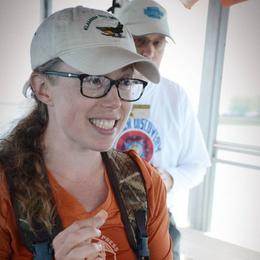Happy Summer Solstice! Migratory birds have settled in across the Great Lakes region and are filling the air with their melodic songs as they establish breeding territories and search for a mate. Over 350 bird species breed throughout the Great Lakes each summer. These birds are easier to identify in summer because many of them have swapped their drab winter colors for brighter and more decorative summer breeding plumage.
Additionally, many birds are singing their unique songs at this time of year filling the woodlands, wetlands, and grasslands of the Great Lakes with their melodic songs, allowing bird watchers to practice birding by ear. Most birds are vocal within three hours of sunrise. If you are looking to experience nature’s symphony don’t wait too long to plan an early morning trip out to your local public lands. Bird song dissipates at the end of the month, as most birds are busy rearing their young and feeding their recent fledglings.
You might notice that your bird feeder isn’t getting as much attention at this time of year. Migrants are heading back to their breeding grounds farther north while some of your usual feeder visitors, like House Finches and Northern Cardinals, are busy nesting and rearing their young.
Some species like Killdeer and American Robins have already fledged their first brood of chicks in June, while others, like American Redstarts and Black Terns are likely still incubating eggs in early summer. American Goldfinches are waiting for wildflower and thistle blooms to peak in July to begin nesting while many of our Great Lakes birds, like Blue-winged Teal, Dickcissels, and Indigo Buntings continue to nest and rear their young into July.
Surprisingly, July marks some of our first departures and arrivals of some fall migrants! Our beloved Ruby-throated Hummingbirds will start departing the end of July, as arctic shorebirds start to arrive on their way south to their wintering grounds.
The Piping Plover, a beloved shorebird, can be found nesting on our coast and beaches throughout the summer. This endangered shorebird is beginning to rebound thanks to local recovery efforts. There are currently about 65-70 nesting pairs in the Great Lakes population annually, and this year marks Ohio’s first nesting Piping Plovers in 83 years! You can help protect Piping Plovers by giving them the space they need to nest and raise their little chicks and to fuel up before their long migration in August and September. Learn more on how you can ‘Share the Love, Share the Shore.’
If you’re new to bird watching or birding check out Audubon’s resource “How to Start Birding.”
Want to plan a summer birding trip but not sure where to start? Check out one of the following Great Lakes birding hotspots.
Illinois
- Montrose Point Bird Sanctuary, Chicago, IL
- Check out the Chicago Region birding trail guide.
- Explore urban nature along Chicago's Riverwalk.
- Discover more birding hotspots in Illinois.
Indiana
- Indiana Dunes National Park and State Park (home of the Indiana Dunes Birding Festival)
- Discover more birding hotspots in Indiana.
Michigan
- Visit one of Michigan’s Seven Wetland Wonders to see Michigan’s water birds and marsh birds and participate in this Summer’s Wetland Wonders Challenge for your chance to win up to $1,000 in outdoor gear! These State Wildlife and Game Areas double as Important Bird Areas and are critical resting and refueling areas for migratory waterfowl, water birds, marsh birds, shorebirds, and songbirds alike! Call the local Wetland Wonder DNR field office for tips on where to go. Learn more about you can participate in the Wetland Wonders Challenge here. Whitefish Point, MI (home of the Whitefish Point Bird Observatory)
- Explore one of Michigan’s 103 Important Bird Areas
- Visit one of Michigan’s 9 Birding Trails
Ohio
- Magee Marsh in Ohio (home of the Biggest Week in Birding Festival and the Black Swamp Bird Observatory)
- Discover more birding hotspots in Ohio.
Wisconsin
















